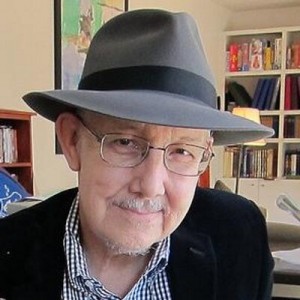 Dmitri Hvorostovsky sings “Lullaby,” the first part of Modest Mussorgsky’s Songs and Dances of Death:
Dmitri Hvorostovsky sings “Lullaby,” the first part of Modest Mussorgsky’s Songs and Dances of Death:
(This is the latest in a series of arts-related videos that appear in this space each Monday and Wednesday.)
Terry Teachout on the arts in New York City
 “We all have to climb out of the pit of desolation, or what is more likely, manage to live in it, planting our flowers among the ashes and squirting them with our gaiety.”
“We all have to climb out of the pit of desolation, or what is more likely, manage to live in it, planting our flowers among the ashes and squirting them with our gaiety.”
Peter De Vries, The Blood of the Lamb
 I grieve to report the passing today of my friend D.G. Myers, a critic of great force and penetration who also blogged eloquently about literature and, more recently, his own terminal cancer.
I grieve to report the passing today of my friend D.G. Myers, a critic of great force and penetration who also blogged eloquently about literature and, more recently, his own terminal cancer.
I made brief but admiring mention of David two weeks ago in this essay about L.E. Sissman. Yesterday I learned that his time was short and wrote this tribute:
David Myers is a tough critical customer. He takes no reputations at face value. All he cares about is the quality of the art object itself, and he applies his standards rigorously and unflinchingly. But that makes him sound like something other than what he is, a thoroughly decent man of deeply humane values who looks to literature for that which great art is uniquely well suited to provide: beauty, clarity, consolation, truth. I in turn have long looked to him for critical guidance, confident that whatever he recommends will be worth reading. We don’t always agree, but I know that I can always take him seriously. That knowledge is a blessing.
It will be published next week in an online Festschrift that is being prepared by Patrick Kurp and to which I will link as soon as it goes on line.
Farewell, David. You were a brave and inspiring soul.
* * *
Jimmy Rushing sings “Goin’ to Chicago Blues” with the Benny Goodman Orchestra in 1958. I sent this video to David when he was having a very bad day a few months ago. It buoyed his spirits then. May it comfort his friends now:
In today’s Wall Street Journal I report on two important shows that I saw during my recent trip to Chicago, Chicago Shakespeare’s King Lear and the Court Theatre’s Native Son. Here’s an excerpt.
* * *
In Chicago Shakespeare’s modern-dress production of “King Lear,” directed by Barbara Gaines, Larry Yando plays the mad old king as a snarling, capricious Frank Sinatra buff who has one foot caught in the quicksand of dementia. If you think that sounds gimmicky, think twice: Mr. Yando and Ms. Gaines have given us a colossal “Lear” whose sheer visceral impact is unrivaled. Watching it is like staring down a typhoon.
 Mr. Yando is well known to Chicago playgoers for his fearlessly forthright acting in Writers’ Theatre’s “Dance of Death” and the Court Theatre’s “Angels in America.” Even for him, though, this is a career-clinching performance, noteworthy not just for its unflagging intensity (he is fully as potent in the first half of the play as he is after intermission) but also for its textured complexity. Great violence alternates unpredictably with great tenderness in Mr. Yando’s Lear. At once frightened and frightening, he lashes out with startling physicality at his family and followers to cloak the slow crumbling of his consciousness, making all the more terrible the question that he asks of his Fool: “Who is it that can tell me who I am?”
Mr. Yando is well known to Chicago playgoers for his fearlessly forthright acting in Writers’ Theatre’s “Dance of Death” and the Court Theatre’s “Angels in America.” Even for him, though, this is a career-clinching performance, noteworthy not just for its unflagging intensity (he is fully as potent in the first half of the play as he is after intermission) but also for its textured complexity. Great violence alternates unpredictably with great tenderness in Mr. Yando’s Lear. At once frightened and frightening, he lashes out with startling physicality at his family and followers to cloak the slow crumbling of his consciousness, making all the more terrible the question that he asks of his Fool: “Who is it that can tell me who I am?”
Ms. Gaines is equally well known for the imaginative integrity of her high-concept Shakespeare stagings, and this “Lear” is exemplary of the virtues of her populist approach. Working closely with Lindsay Jones, the sound designer, she has woven Sinatra’s recordings into the fabric of the play, using “Angel Eyes,” the Matt Dennis torch song whose haunting last line is “’Scuse me while I disappear,” as a recurring motif that foreshadows to wrenchingly apposite effect Lear’s final disintegration….
“Native Son,” Richard Wright’s 1940 novel about a young black man from Chicago who recaptures his lost masculinity by killing a rich white debutante, is so inherently dramatic that several adaptations have made it to the stage, starting with the now-legendary Mercury Theatre version by Orson Welles and John Houseman that ran on Broadway in 1941. Now the latest version, adapted by Nambi E. Kelley and directed by Seret Scott, is being performed to stirring and timely effect by the Court Theatre.
The challenge of dramatizing “Native Son” is that the book relies on third-person narration. Ms. Kelley has responded by splitting Bigger Thomas, the protagonist, into the “real” Bigger (Jerod Haynes) and an alter ego (Eric Lynch) who gives voice to his suppressed inner thoughts, a convention similar to that employed by Brian Friel in “Philadelphia, Here I Come!” It’s a convincing theatrical illustration of the way in which Bigger emasculates himself by hiding his simmering rage from the white world, and Messrs. Haynes and Lynch fit their dynamic performances together like the two sides of a freshly minted coin….
* * *
To read my review of King Lear, go here.
To read my review of Native Son, go here.
The trailer for Chicago Shakespeare’s King Lear:
Frank Sinatra sings “Angel Eyes” on The Frank Sinatra Timex Show in 1959:
 In today’s Wall Street Journal “Sightings” column I discuss the critical and political contretemps stirred up by the opening of the Metropolitan Museum of Art’s new David H. Koch Plaza. Here’s an excerpt.
In today’s Wall Street Journal “Sightings” column I discuss the critical and political contretemps stirred up by the opening of the Metropolitan Museum of Art’s new David H. Koch Plaza. Here’s an excerpt.
* * *
If you’ve walked past New York’s Metropolitan Museum of Art lately, you’ll have noticed the brand-new plaza in front of the building with the Beaux-Arts façade that is home to America’s greatest art collection. Whenever alterations are made to a familiar structure, opinions usually vary widely and sharply. But one view is currently drowning out all others: Several art critics are miffed by the fact that golden letters emblazoned on the Met’s new twin fountains identify the site as the David H. Koch Plaza, in honor of the trustee who wrote the $65 million check that paid for it in full….
These critics, and others like them, appear to have at least as much of a problem with Mr. Koch as they do with “his” plaza. Why? If you pay any attention to politics, you won’t need to be told that Mr. Koch, the ninth-richest man in America, is the junior half of the notorious Koch Brothers, who give huge sums of money to right-of-center politicians and causes….
In our bipolar age, political purists are increasingly disposed to raise a stink whenever arts groups accept gifts from sources deemed by said purists to be unworthy. This tendency initially manifested itself in the case of tobacco companies like Philip Morris International that supported the arts. No doubt the company’s commitment to what it calls “corporate social responsibility” was in part an attempt to divert attention from its less-than-socially responsible products. Nevertheless, the fact of its generosity is not to be ignored—or despised….
* * *
Read the whole thing here.
 I thought it might be worth reminding you that I’ll be making a public appearance on Monday night as part of Project Shaw’s staged reading of George Bernard Shaw’s Village Wooing, a little-known comic two-hander written in 1933. I’ll be sharing the stage of Symphony Space with Jefferson Mays and J. Smith-Cameron, of whose fabulous talents regular theatergoers doubtless already aware. They’ll be doing all the acting, thank heavens. My sole function will be to read the stage directions out loud in my most mellifluous voice.
I thought it might be worth reminding you that I’ll be making a public appearance on Monday night as part of Project Shaw’s staged reading of George Bernard Shaw’s Village Wooing, a little-known comic two-hander written in 1933. I’ll be sharing the stage of Symphony Space with Jefferson Mays and J. Smith-Cameron, of whose fabulous talents regular theatergoers doubtless already aware. They’ll be doing all the acting, thank heavens. My sole function will be to read the stage directions out loud in my most mellifluous voice.
Symphony Space is at 95th Street and Broadway. The show starts at seven p.m. on Monday. To order tickets or for more information, go here.
 Jerry Jazz Musician, a web-based magazine out of Portland, Oregon, that describes itself as being “devoted to jazz and 20th-century America,” has just published a symposium that asks the following question: “What are 3 or 4 of your favorite jazz record albums of the 1970′s?” The participants include (among others) Michael Cuscuna, Eliane Elias, Gary Giddins, Bennie Maupin, Marc Myers, Tierney Sutton, and me. Not surprisingly, our choices ranged very widely.
Jerry Jazz Musician, a web-based magazine out of Portland, Oregon, that describes itself as being “devoted to jazz and 20th-century America,” has just published a symposium that asks the following question: “What are 3 or 4 of your favorite jazz record albums of the 1970′s?” The participants include (among others) Michael Cuscuna, Eliane Elias, Gary Giddins, Bennie Maupin, Marc Myers, Tierney Sutton, and me. Not surprisingly, our choices ranged very widely.
To see what albums we picked, go here.
| M | T | W | T | F | S | S |
|---|---|---|---|---|---|---|
| 1 | 2 | |||||
| 3 | 4 | 5 | 6 | 7 | 8 | 9 |
| 10 | 11 | 12 | 13 | 14 | 15 | 16 |
| 17 | 18 | 19 | 20 | 21 | 22 | 23 |
| 24 | 25 | 26 | 27 | 28 | ||
An ArtsJournal Blog